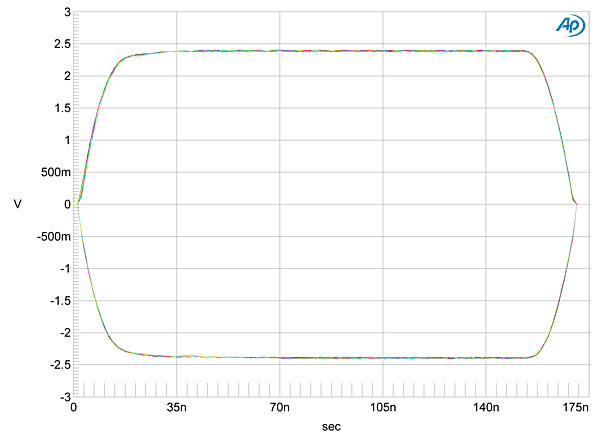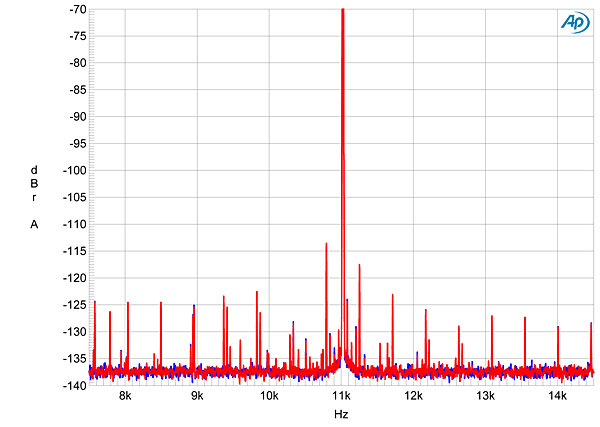| Columns Retired Columns & Blogs |
The M2Tech Hiface at $150 seems like an obvious comparison. It is also asynch, but goes up to 192 KHz. Any comparison of it with the V-Link?
I examined the measured behavior of the Musical Fidelity V-Link using the Audio Precision SYS2722 system (see www.ap.com and "As We See It" in the January 2008 issue), as well as the Miller Audio Research Jitter Analyzer. I played test tones at various sample rates and bit depths from BIAS Peak Pro 6 on an Intel MacBook running OS10.6.4, with some tests repeated on a dual-core PC running Windows 7 and Adobe Audition 3.0.
The V-Link operated at sample rates of 32, 44.1, 48, 88.2, and 96kHz, provided the sample rate had been set correctly with Audio MIDI Setup on the Mac or Audio Devices–Properties on the PC. To check that the V-Link was bit-transparent, I fed its S/PDIF output to an RME soundcard fitted to a second PC, and recorded the data using Adobe Audition. When I played that recording simultaneously with an inverted, bit-synchronized version of the original audio file, there was a perfect null with both 16- and 24-bit data. The bits output from the converter via S/PDIF were therefore the same bits sourced from the host computer via USB. When I used RME's DIGICheck utility to examine how many bits were active in the Musical Fidelity's S/PDIF output, the number of active bits followed how many had been set in the computer's Control Panel: 16 or 24, as appropriate.
The USB Prober program revealed that the V-Link operated in isochronous asynchronous mode, as specified. The "eye pattern" of the S/PDIF data waveform, connected via 15' of plastic TosLink, was wide open and free from timing uncertainty at its start and end (fig.1), and the Audio Precision System SYS2722 calculated the jitter in this datastream to be a very low 395 picoseconds peak. This is not quite as low as the Halide S/PDIF Bridge, which measured 345ps peak, but was the same as the Stello U2. (All figures calculated with a 50Hz–100kHz measurement bandwidth.)

Fig.1 Musical Fidelity V-Link, eye pattern of S/PDIF data output carrying 16-bit J-Test signal (±500mV vertical scale, 175ns horizontal scale).
Any improvement in jitter performance offered by something like the V-Link will depend on the jitter rejection of the DAC to which it is connected (footnote1). I looked at the effects of datastream jitter in the reconstructed analog signal with a 1998 sample of Musical Fidelity's X-24K D/A processor, which is sensitive to incoming datastream jitter. To set a baseline for the X-24K's performance when fed 16-bit J-Test data, fig.2 shows the narrowband spectrum of its analog output when fed the data from the Audio Precision SYS2722 via 15' of plastic TosLink. While there is some accentuation of the primary, data-related sidebands at ±229Hz, which the Miller Analyzer calculated as being equivalent to 150ps peak–peak left and 143ps p–p right, and a pair of low-frequency sidebands at ±60Hz, the X-24K's spectrum is very clean, all other data-related sidebands lying at the residual level of the test signal's low-frequency squarewave harmonics.

Fig.2 Musical Fidelity X-24K, high-resolution jitter spectrum of analog output signal, 11.025kHz at –6dBFS, sampled at 44.1kHz with LSB toggled at 229Hz, 16-bit S/PDIF data from Audio Precision SYS2722 via 15' TosLink. Center frequency of trace, 11.025kHz; frequency range, ±3.5kHz (left channel blue, right red).
By contrast, fig.3 shows the spectrum of the X-24K's output when it was fed the 16-bit J-Test data from the MacBook's optical output, again via 15' of plastic TosLink. The data-related sidebands have risen in level, to give 219/224ps p–p of jitter left and right, respectively. Though the noise floor is a little dirtier than in fig.3, this jitter level is still very low in absolute terms. Playing back the same data from the MacBook, this time via USB to the V-Link and then via 15' of TosLink, gave the spectrum shown in fig.4. The jitter has dropped slightly, to 214/211ps p–p, but there are now some low-level noise spikes apparent between 8 and 9kHz. Though these don't appear to be jitter-related, I'd rather they weren't there.

Fig.3 Musical Fidelity X-24K, high-resolution jitter spectrum of analog output signal, 11.025kHz at –6dBFS, sampled at 44.1kHz with LSB toggled at 229Hz, 16-bit S/PDIF data from MacBook via 15' TosLink. Center frequency of trace, 11.025kHz; frequency range, ±3.5kHz (left channel blue, right red).

Fig.4 Musical Fidelity X-24K, high-resolution jitter spectrum of analog output signal, 11.025kHz at –6dBFS, sampled at 44.1kHz with LSB toggled at 229Hz, 16-bit S/PDIF data from MacBook via Musical Fidelity V-Link and 15' TosLink. Center frequency of trace, 11.025kHz; frequency range, ±3.5kHz (left channel blue, right red).
Fig.5 shows the spectrum of the X-24K's output when fed the 16-bit J-Test data from the V-Link's coaxial output via 1m of 75-ohm S/PDIF interconnect. (The X-24K was fussy about how this cable was dressed, at times losing lock.) The data-related sidebands have risen in level, to give a calculated 425/431ps p–p left and right, respectively, though the spectrum otherwise looks similar to that in fig.4.

Fig.5 Musical Fidelity X-24K, high-resolution jitter spectrum of analog output signal, 11.025kHz at –6dBFS, sampled at 44.1kHz with LSB toggled at 229Hz, 16-bit S/PDIF data from MacBook via Musical Fidelity V-Link and 1m 75 ohm datalink. Center frequency of trace, 11.025kHz; frequency range, ±3.5kHz (left channel blue, right red).
Repeating this test with the dCS Debussy, with which I did most of the auditioning, I got a spectrum with the harmonics of the low-level squarewave at the residual level and the jitter below the resolution limit of the Miller Analyzer. The spectrum of the Debussy reproducing the 16-bit J-Test data via the V-Link is shown in fig.6 (cyan and red traces). The spectrum with 24-bit data is shown as the blue and magenta traces. If you compare this graph very carefully with fig.13 in the Debussy's measurements, which shows the Debussy's spectrum when driven directly by USB-sourced 16-bit data, you can see that the central peak representing the 11.025kHz tone is slightly widened at its base when the V-Link is used, suggesting the presence of some very-low-frequency random jitter. There are also slight sidebands visible at ±48 and ±120Hz. The 120Hz pair are obviously supply-related, but I have no idea where the 48Hz pair arise from. Perhaps they are an artifact of the frequency-synthesized clock in the V-Link's TAS1020B chip.—John Atkinson

Fig.6 dCS Debussy, high-resolution jitter spectrum of analog output signal, 11.025kHz at –6dBFS, sampled at 44.1kHz with LSB toggled at 229Hz, 16-bit (left channel cyan, right red) and 24-bit (left blue, right magenta) S/PDIF data from MacBook via Musical Fidelity V-Link and 1m 75 ohm datalink. Center frequency of trace, 11.025kHz; frequency range, ±3.5kHz.

The M2Tech Hiface at $150 seems like an obvious comparison. It is also asynch, but goes up to 192 KHz. Any comparison of it with the V-Link?

What %age of products reviewed are from non-advertisers?
What %age of other than breathlessly positive reviews come from advertisers?

"What %age of products reviewed are from non-advertisers?"
The last time I did an analysis, in 2007, 53% of products reviewed in Stereophile were made by companies that didn't advertise (see the second footnote at the linked article). The proportion is not different today, as far as I can tell.